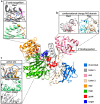A prokaryotic twist on argonaute function
- PMID: 25692904
- PMCID: PMC4390867
- DOI: 10.3390/life5010538
A prokaryotic twist on argonaute function
Abstract
Argonaute proteins can be found in all three domains of life. In eukaryotic organisms, Argonaute is, as the functional core of the RNA-silencing machinery, critically involved in the regulation of gene expression. Despite the mechanistic and structural similarities between archaeal, bacterial and eukaryotic Argonaute proteins, the biological function of bacterial and archaeal Argonautes has remained elusive. This review discusses new findings in the field that shed light on the structure and function of Argonaute. We especially focus on archaeal Argonautes when discussing the details of the structural and dynamic features in Argonaute that promote substrate recognition and cleavage, thereby revealing differences and similarities in Argonaute biology.
Figures



References
-
- Lin H., Spradling A.C. A novel group of pumilio mutations affects the asymmetric division of germline stem cells in the drosophila ovary. Development. 1997;124:2463–2476. - PubMed
Publication types
LinkOut - more resources
Full Text Sources
Other Literature Sources

